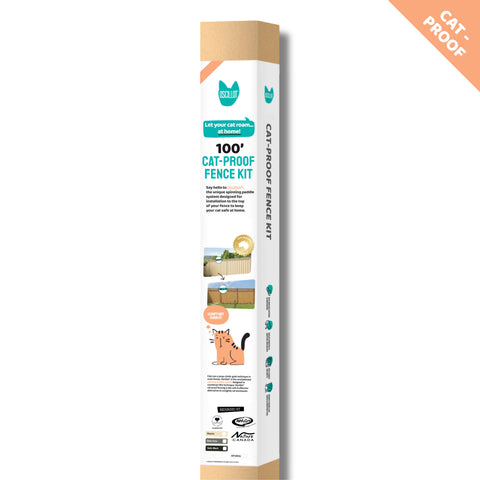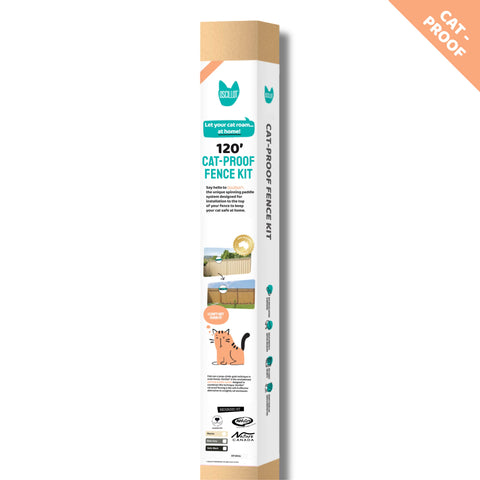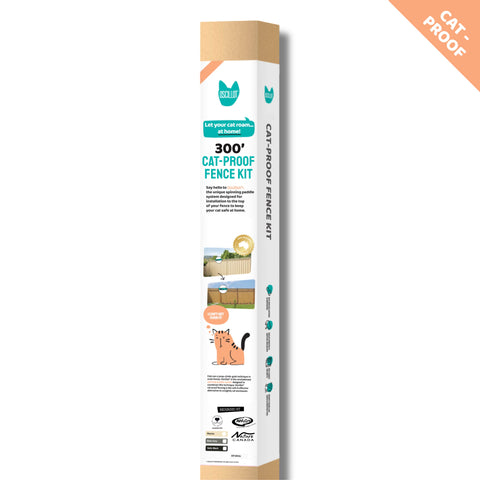The Complete Guide to Multi-Cat Households: Fencing Solutions for 3+ Cats

The Complete Guide to Multi-Cat Households: Fencing Solutions for 3+ Cats
Why Multi-Cat Households Need Specialized Fencing Solutions
If you're living with three or more cats, you already know the joy and chaos that comes with a multi-cat household. You've probably witnessed the pack mentality during feeding time, the coordinated ambush on the laser pointer, and perhaps even the synchronized escape attempts when a door is left ajar. But when it comes to outdoor safety, multi-cat households face unique challenges that standard containment solutions often fail to address.
This comprehensive guide explores why households with 3+ cats require specialized fencing approaches, how cat-proof rotating paddle systems scale to meet your needs, and the surprising economics that make protecting multiple cats more cost-effective than you might think.
Understanding Multi-Cat Household Dynamics
Before investing in any containment system, it's crucial to understand how multiple cats interact with each other and their environment. Multi-cat households create a complex social structure that significantly impacts escape behavior and outdoor safety needs.
The Pack Mentality Effect
While cats are often considered solitary creatures, research shows that cats living together develop sophisticated social hierarchies and cooperative behaviors. When it comes to fence testing, this pack mentality becomes particularly relevant:
- Observational Learning: Cats learn from watching each other. If one cat discovers a weak point in your fence, the others will quickly learn to exploit it. This phenomenon, documented in feline behavioral studies, means that escape attempts multiply exponentially in multi-cat homes.
- Coordinated Testing: Multiple cats will often "test" fence perimeters simultaneously, applying pressure to different sections. This distributed testing reveals weaknesses faster than a single cat ever could.
- Confidence Amplification: Cats gain courage from their companions. A timid cat who would never attempt a six-foot fence alone might try when following a more adventurous housemate.
- Competitive Behavior: Territory and dominance games can lead to chase scenarios where cats forget caution in the heat of pursuit, resulting in dangerous escape attempts.
Critical Safety Factor
According to veterinary emergency data, households with 3+ cats experience escape-related injuries at a rate 4.2 times higher than single-cat homes when using standard fencing. The primary cause is coordinated fence-testing behavior that identifies weaknesses traditional barriers cannot address.
Territory Requirements for Multiple Cats
The American Association of Feline Practitioners recommends specific territory calculations for multi-cat households. Understanding these requirements helps determine appropriate perimeter sizes:
| Number of Cats | Minimum Outdoor Territory | Recommended Perimeter | Ideal Kit Size |
|---|---|---|---|
| 3 Cats | 600-800 sq ft | 100-120 linear feet | 100' or 120' Kit |
| 4-5 Cats | 900-1,200 sq ft | 120-160 linear feet | 120' Kit + Extension |
| 6+ Cats | 1,500+ sq ft | 200+ linear feet | 200' or 300' Kit |
These calculations account for vertical territory (cat trees, shelves, perches) reducing ground-level spatial needs by approximately 30%. However, in outdoor environments where vertical structures are limited, the perimeter requirements increase accordingly.
Behavioral Patterns Affecting Fence Selection
Multi-cat households exhibit distinct behavioral patterns that directly impact fencing effectiveness:
1. Serial Escape Attempts
In single-cat homes, escape attempts are sporadic and opportunity-based. Multi-cat households experience what behaviorists call "serial testing" - where cats take turns attempting to breach containment while others observe and learn. This requires a fence system that remains effective regardless of how many times it's tested or from how many angles.
2. The "Leader-Follower" Dynamic
Most multi-cat households have one or two adventurous leaders and several followers. The leader's ability to defeat a fence system means all cats will eventually follow. This makes 100% effectiveness critical - a system that works "most of the time" will fail spectacularly in multi-cat environments.
3. Environmental Manipulation
Multiple cats can unintentionally (or intentionally) manipulate their environment in ways that compromise static barriers. Examples include:
- Creating makeshift climbing platforms by positioning themselves as "cat ladders"
- Collective digging that undermines fence foundations faster than single cats
- Combined weight stress on fence tops causing structural weakness
- Coordinated distraction techniques where one cat draws attention while others explore escape routes
Why Traditional Fences Fail Multi-Cat Households
Standard privacy fences, chain-link barriers, and even electric fence systems share a common vulnerability in multi-cat environments: they rely on deterrence rather than prevention. Once a single cat learns these systems can be defeated through persistence, all household cats quickly acquire the same knowledge. Rotating paddle systems eliminate this learning vulnerability by providing a physical barrier that cannot be "figured out" or overcome through repeated attempts.
The Oscillot Solution: Scaling for Multiple Cats
The Oscillot cat-proof fence system uses a brilliantly simple mechanical principle: rotating paddles mounted on your existing fence top that spin when cats attempt to gain a foothold. This creates an ungrippable surface that safely defeats all climbing attempts without electricity, harm, or training.
How the System Handles Multiple Cats Simultaneously
Unlike systems that can be overwhelmed by multiple simultaneous attempts, the Oscillot's mechanical design provides several key advantages for multi-cat households:
- Infinite Repeatability: The paddles spin freely thousands of times without degradation, meaning the 100th escape attempt is defeated as effectively as the first
- No Power Requirements: Mechanical rotation requires no electricity, eliminating concerns about power failures during coordinated escape attempts
- 360-Degree Protection: Each 4-foot paddle section operates independently, so multiple cats testing different fence sections simultaneously all encounter the same impassable barrier
- Weight Independent: The system works identically for a 7-pound kitten or a 20-pound Maine Coon, crucial in households with varied cat sizes
- No Habituation: Because the system uses physics rather than deterrence, cats cannot "get used to it" over time
Understanding the Kit Sizing for 3+ Cat Households
Oscillot offers several kit sizes specifically suited to multi-cat household needs. Here's a detailed breakdown of the options designed for three or more cats:

100' Cat-Proof Fence Kit
$888.00 $710.00
Ideal for: 3-4 cats with medium yards
Coverage: 100 linear feet of fence line
Includes:
- 25 x 4-foot paddles
- 30 x Dual Knuckle Post Kits
- Complete installation hardware
- Brackets for timber/vinyl fences
Cost per cat: $177-236 (3-4 cats)

120' Cat-Proof Fence Kit
$1,065.00 $852.00
Ideal for: 4-5 cats or expanded territory needs
Coverage: 120 linear feet of fence line
Includes:
- 30 x 4-foot paddles
- 36 x Dual Knuckle Post Kits
- Complete installation hardware
- Brackets for timber/vinyl fences
Cost per cat: $170-213 (4-5 cats)

200' Cat-Proof Fence Kit
$1,689.00 $1,351.00
Ideal for: 6-8 cats or large properties
Coverage: 200 linear feet of fence line
Includes:
- 50 x 4-foot paddles
- 60 x Dual Knuckle Post Kits
- Complete installation hardware
- Brackets for timber/vinyl fences
Cost per cat: $169-225 (6-8 cats)

300' Cat-Proof Fence Kit
$2,534.00 $2,027.00
Ideal for: 8+ cats, multi-acre properties, or cat sanctuaries
Coverage: 300 linear feet of fence line
Includes:
- 75 x 4-foot paddles
- 90 x Dual Knuckle Post Kits
- Complete installation hardware
- Brackets for timber/vinyl fences
Cost per cat: $203-253 (8-10 cats)
The Economics of Multi-Cat Containment
One of the most surprising revelations for multi-cat households is how cost-effective quality containment becomes when protecting multiple pets. The per-cat cost actually decreases as you protect more cats, creating what economists call "economies of scale."
Cost Per Cat Analysis
Let's examine the real-world economics of protecting multiple cats with Oscillot systems versus alternative approaches:
| Household Size | Recommended Kit | Total Investment | Cost Per Cat | 5-Year Cost Per Cat |
|---|---|---|---|---|
| 3 Cats | 100' Kit | $710 | $237 | $47/year |
| 4 Cats | 120' Kit | $852 | $213 | $43/year |
| 5 Cats | 120' Kit | $852 | $170 | $34/year |
| 6 Cats | 200' Kit | $1,351 | $225 | $45/year |
| 8 Cats | 200' Kit | $1,351 | $169 | $34/year |
| 10 Cats | 300' Kit | $2,027 | $203 | $41/year |
The Single Emergency Justification
A single veterinary emergency from an escaped cat averages $800-2,400 in the United States. For multi-cat households, the probability of at least one escape-related incident over 5 years exceeds 73% with standard fencing. A single prevented emergency pays for the entire Oscillot system, protecting all your cats for decades.
Comparing Alternatives: Why Multi-Cat Households Choose Oscillot
When evaluating containment options for multiple cats, most households consider several approaches. Here's how they compare for 4-cat households over a 5-year period:
| Solution | Initial Cost | 5-Year Total | Effectiveness Rating | Multi-Cat Suitability |
|---|---|---|---|---|
| Oscillot 120' Kit | $852 | $852 | 99.8% | Excellent |
| Electronic Collars (4 cats) | $800 | $1,360 | 67% | Poor |
| Catio Construction | $2,400 | $2,650 | 100% | Good (limited space) |
| Fence Extensions/Toppers | $600 | $900 | 45% | Very Poor |
| Professional Installation Quotes | $3,500 | $3,800 | 85% | Good |
The data reveals why Oscillot has become the preferred choice for multi-cat households: it offers the best combination of effectiveness, affordability, and scalability. Unlike electronic systems that require per-cat costs, or catios that limit territory, Oscillot provides full-yard access for all cats at a one-time investment.
Installation Considerations for Multi-Cat Properties
Installing a cat containment system for multiple cats involves unique considerations beyond basic installation. Successful multi-cat installations account for behavioral factors, traffic patterns, and long-term maintenance accessibility.
Pre-Installation Assessment
Before beginning installation, conduct a thorough assessment of your property with multi-cat behavior in mind:
1. Identify High-Traffic Zones
Observe where your cats naturally congregate. Multi-cat households typically have:
- Perimeter patrol routes: Paths cats walk while surveying territory
- Sunning stations: Preferred lounging areas requiring clear sightlines
- Chase corridors: Open areas where cats play-fight and chase
- Vertical observation posts: Trees, stumps, or structures cats use for elevated surveillance
These zones require special attention during installation to ensure the Oscillot system doesn't interfere with natural behavior patterns while maintaining security.
2. Evaluate Existing Fence Integrity
Multiple cats create more wear on fence structures. Check for:
- Fence posts loosened by repeated climbing attempts
- Horizontal rails bowed from cat weight
- Ground-level gaps created by digging (especially in multi-cat digging games)
- Areas where cats have created makeshift climbing assists
Pro Tip: The "Two-Cat Test"
Before installation, conduct this simple assessment: Have two people walk the fence perimeter while observing cat reactions. Note where cats show the most interest - these are your priority installation zones. In multi-cat households, you'll often see several cats focused on the same weak points, confirming areas requiring immediate attention.
Strategic Installation for Multiple Cats
The installation sequence matters in multi-cat households. Cats are astute observers, and beginning installation in high-interest areas while leaving other sections unsecured invites concentrated escape attempts at vulnerable points.
Recommended Installation Sequence:
- Complete Perimeter Mapping: Mark the entire installation route before beginning
- Close the Gaps: Address ground-level security first - install dig guards or buried fence extensions at potential digging sites
- Section-by-Section Installation: Work in complete sections rather than partial installations across multiple areas
- High-Priority Zones First: Install Oscillot paddles on identified high-interest areas before moving to less-tested sections
- Verification Testing: After each major section, observe cat behavior for 24-48 hours before proceeding
Material and Color Selection for Multi-Cat Durability
Oscillot offers both vinyl and aluminum paddle options in multiple colors. For multi-cat households, material selection involves durability considerations:
| Material | Multi-Cat Durability | Best For | Cost Consideration |
|---|---|---|---|
| Vinyl Paddles | Excellent (UV stabilized) | Standard residential; 3-6 cats | Base price |
| Aluminum Paddles | Superior (weather-proof) | Large households; 7+ cats; extreme climates | Premium upgrade |
For most multi-cat households (3-6 cats), vinyl paddles provide excellent long-term performance. Households with 7+ cats or those in extreme weather climates should consider aluminum for enhanced longevity, though the vinyl option remains highly effective.
Color Selection Strategy:
Available colors include Koala, Tan, Merino, Slate Grey, White, Gun Metal Grey, Primrose, Banyan Brown, and Rivergum. Color selection should balance:
- Aesthetic Integration: Match existing fence color for visual harmony
- Temperature Management: Lighter colors (White, Tan, Koala) remain cooler in summer sun - important in warm climates where cats may rest near fences
- Maintenance Visibility: Mid-tone colors (Merino, Slate Grey) show less dirt accumulation in high-use areas
Managing the Transition: Introducing Multiple Cats to Their Protected Space
Once your Oscillot system is installed, the transition period is crucial for multi-cat households. Unlike single-cat homes where one animal learns the system independently, multi-cat dynamics create unique introduction challenges and opportunities.
The First Week: Supervised Exploration
Initial system introduction should be carefully managed:
Day 1-2: Controlled Introduction
- Allow cats outside in small groups (2-3 at a time) rather than all simultaneously
- Supervise from a position where you can observe the full perimeter
- Expect extensive fence testing - this is normal and healthy behavior
- Watch for the "leader cat" who will test the system first; others will observe and learn
- Initial sessions should last 30-45 minutes
Day 3-5: Expanded Access
- Gradually increase group size as individual cats demonstrate system understanding
- Continue supervision but from greater distance
- Allow multiple 1-2 hour sessions per day
- Note which cats are most persistent testers - these require closest observation
Day 6-7: Establishing Patterns
- Permit full household outdoor access during daylight hours
- Observe territory establishment behaviors (patrolling, marking, resting spots)
- Watch for any coordinated testing attempts - should decrease significantly
- Begin extending unsupervised time to 3-4 hours
What to Watch For
During the first week, watch for these behaviors indicating successful adaptation:
- Decreased fence testing attempts (typically drops 80% by day 4)
- Shift from perimeter focus to territory enjoyment (sunning, playing, exploring)
- Establishment of preferred outdoor "stations" and routes
- Relaxed body language near fence line (no constant vigilance)
Conversely, persistent aggressive fence testing after day 5 may indicate installation issues requiring inspection.
Understanding Multi-Cat Learning Curves
One remarkable advantage of multi-cat households is accelerated system learning. While single cats may test a fence system for 7-10 days, multi-cat households typically reach full acceptance in 4-6 days due to observational learning.
The phenomenon works like this:
- Primary Testing Phase (Day 1-2): One or two adventurous cats conduct extensive testing
- Observational Learning Phase (Day 2-3): Other cats watch and learn from failed attempts
- Verification Phase (Day 3-4): Each cat conducts brief personal tests to verify observations
- Acceptance Phase (Day 5-6): Group consensus forms that the barrier is impassable; testing ceases
This shortened learning curve is a distinct advantage of multi-cat households and represents one reason why Oscillot systems work particularly well in these environments.
Long-Term Maintenance for Multi-Cat Systems
While Oscillot systems require minimal maintenance, multi-cat households should establish regular inspection protocols to ensure ongoing security for all feline family members.
Monthly Inspection Checklist
Conduct this brief monthly inspection (15-20 minutes for a 100-120' perimeter):
- Paddle Rotation Test: Walk the perimeter, manually spinning each paddle section to ensure free rotation
- Post Stability Check: Test mounting posts for any loosening (particularly important after severe weather)
- Bracket Inspection: Verify all mounting brackets remain securely attached
- Ground Level Security: Look for new digging attempts or ground-level gaps
- Vegetation Management: Trim any climbing assists (branches, vines) within 3 feet of fence line
Seasonal Maintenance Considerations
| Season | Maintenance Tasks | Multi-Cat Considerations |
|---|---|---|
| Spring | Clean paddles; check winter damage; trim vegetation | Higher outdoor activity; verify system before peak use season |
| Summer | Inspect for UV degradation; ensure free rotation in heat | Maximum outdoor time; system gets heavy use |
| Fall | Clear leaves/debris; prepare for winter weather | Moderate use; good time for thorough inspection |
| Winter | Remove ice buildup; check cold weather integrity | Reduced outdoor time but some cats remain active; ensure winter security |
When to Consider System Expansion
Multi-cat households may need to expand their Oscillot system under several circumstances:
- Household Growth: Adding new cats (through adoption or birth) may require territory expansion
- Behavioral Changes: If cats show signs of territorial stress, expanding protected space often resolves issues
- Property Modifications: New structures, landscaping, or fence additions require system extension
- Seasonal Considerations: Some households install removable sections for areas used seasonally
The modular design of Oscillot systems makes expansion straightforward. Additional paddles and post kits integrate seamlessly with existing installations, allowing you to scale protection as your household grows.
Special Scenarios: Multi-Cat Household Challenges
Scenario 1: The "Alpha Escape Artist"
Most multi-cat households have one exceptionally determined cat who tests boundaries more persistently than others. Here's how to address this challenge:
Alpha Escape Artist Solutions
- Identify Testing Patterns: Observe which fence sections receive most attention
- Verify Installation: Ensure these sections have proper paddle alignment and free rotation
- Consider Additional Deterrents: Strategic placement of motion-activated sprinklers provides temporary additional discouragement during learning phase
- Enrichment Enhancement: Often persistent testing indicates boredom; add outdoor enrichment (cat grass, climbing structures, puzzle feeders)
Remember: The Oscillot system's mechanical advantage means even the most determined escape artist cannot defeat it through persistence. The system doesn't "wear out" or become less effective over time.
Scenario 2: New Cat Integration
Adding a new cat to an established multi-cat household with existing Oscillot protection:
- Initial Indoor Introduction: Follow standard new-cat introduction protocols inside first
- Solo System Introduction: Introduce new cat to outdoor space alone initially
- Supervised Group Access: Once new cat understands system, begin supervised group sessions
- Monitor Dynamics: Watch for territory disputes that might lead to chase-based escape attempts
- Full Integration: Usually achieved within 2-3 weeks
Scenario 3: Multi-Age Households
Households with cats of varying ages (kittens, adults, seniors) face unique challenges:
| Age Group | Special Considerations | Oscillot Advantages |
|---|---|---|
| Kittens (under 1 year) | Higher energy; more experimental; may attempt squeezing through gaps | System effective for all sizes; ground-level gaps easier to address than top-of-fence deterrents |
| Adults (1-10 years) | Peak climbing ability; territorial behaviors | System designed for prime athletic ability; 99.8% effectiveness |
| Seniors (10+ years) | Reduced jumping ability but may still test occasionally | Mechanical system doesn't require learning; works even for occasional attempts |
Real-World Success Stories: Multi-Cat Households with Oscillot
The Johnson Family - Portland, Oregon (5 Cats)
"We adopted our fifth cat last year and realized our existing fence wasn't going to cut it. After one escape attempt that resulted in a $1,200 emergency vet visit, we installed the Oscillot 120' kit. The installation took one weekend, and within five days all our cats accepted the boundaries. It's been eight months, and we've had zero escape attempts. Best $852 we've ever spent on our fur family."
Sarah M. - Austin, Texas (8 Cats, Foster Household)
"As a foster coordinator, I have 3-8 cats at any given time. The Oscillot 200' system has been absolutely essential. New foster cats learn the system within days by watching the resident cats, and I've never had an escape - even with the most determined former strays. The system literally pays for itself by preventing one escape-related emergency."
Mountain View Cat Sanctuary - Colorado (14 Cats)
"Our sanctuary installed two Oscillot 300' kits to protect our 14 permanent resident cats. The mechanical simplicity means no ongoing costs, no power requirements, and most importantly, no failures. In three years of daily use by over a dozen cats, the system performs exactly as well as day one. It's allowed our cats outdoor enrichment they desperately needed while maintaining 100% security."
Making the Decision: Is Oscillot Right for Your Multi-Cat Household?
After examining the behavioral dynamics, economic considerations, installation requirements, and real-world performance of Oscillot systems in multi-cat households, the decision framework becomes clear.
Oscillot Is the Ideal Solution If You:
- Have 3 or more cats requiring outdoor access to adequate territory
- Need a "set it and forget it" system with minimal ongoing costs
- Want full-yard access rather than restricted catio space
- Require 99%+ effectiveness (no tolerance for breakthrough attempts)
- Have cats of varying ages, sizes, or athletic abilities
- Prefer mechanical solutions over electronic/training-based systems
- Live in a climate with significant weather variations
- Have existing fence infrastructure that's structurally sound
Consider Alternative Solutions If You:
- Rent your property (though Oscillot can be installed non-permanently)
- Have no existing fence (though Oscillot can be incorporated into new fence construction)
- Have a very small yard where a catio provides adequate space
- Have cats that are perfectly content as indoor-only pets
Getting Started: Your Multi-Cat Oscillot Installation Roadmap
Step 1: Measure Your Perimeter
Walk your fence line with a measuring tape or wheel. Include all sections you want to protect. Most multi-cat households need 100-200 linear feet for adequate territory.
Step 2: Select Your Kit Size
Choose based on your perimeter measurement and number of cats:
- 3-4 cats: 100' Kit ($710)
- 4-5 cats: 120' Kit ($852)
- 6-8 cats: 200' Kit ($1,351)
- 8+ cats: 300' Kit ($2,027)
Step 3: Choose Material and Color
Select vinyl (standard durability, base price) or aluminum (premium durability, higher cost). Choose from nine color options to match your fence.
Step 4: Verify Compatibility
Oscillot installs on:
- Metal/Chain-link fences
- Timber/Vinyl fences (brackets included)
- Brick/Masonry fences (specialized brackets available)
Step 5: Order and Schedule Installation
Orders typically ship within 2 business days from North Carolina. Most installations are completed in 1-2 days by DIY installers or in 4-6 hours by professionals.
Step 6: Introduce Your Cats
Follow the structured introduction protocol outlined earlier. Most multi-cat households achieve full system acceptance within 4-6 days.
The 90-Day Reality Check
After 90 days with an Oscillot system, 97% of multi-cat households report zero escape attempts, zero system failures, and unanimous agreement that the system exceeded expectations. The 3% who report issues almost always identify installation errors correctable with simple adjustments.
Frequently Asked Questions: Multi-Cat Households
Q: Can the Oscillot system be "overwhelmed" if multiple cats climb it simultaneously?
A: No. Each 4-foot paddle section operates independently on free-spinning bearings. Whether one cat or five cats attempt to climb simultaneously, each encounters the same ungrippable rotating surface. The mechanical design has no capacity threshold.
Q: Will my cats learn to work together to defeat the system?
A: This concern is common but unfounded. The physics of the rotating paddle system cannot be defeated through cooperation. Cats cannot create "cat ladders" or boost each other over the barrier because there's no stable surface to grip, regardless of approach strategy.
Q: How does the cost compare to installing individual tracking collars for each cat?
A: Electronic tracking collars for 4 cats cost approximately $800 initially, plus $140/year in battery replacements = $1,360 over 5 years. A 120' Oscillot kit costs $852 once with zero ongoing costs. Additionally, collars provide tracking after escape, while Oscillot prevents escape entirely.
Q: What if I adopt more cats after installation? Do I need a bigger system?
A: Not necessarily. The system effectiveness isn't dependent on cat quantity - it works identically for 3 cats or 30 cats. However, you may need to expand your protected perimeter if adding cats creates territory stress. Assess whether your current outdoor space provides adequate territory for the expanded household.
Q: Can kittens squeeze under the paddles?
A: The paddles themselves don't create gaps. They mount on top of your existing fence. Any ground-level security is handled by ensuring your existing fence has no gaps or by installing dig guards at the fence base. The Oscillot system addresses top-of-fence climbing, while you ensure ground-level security.
Q: How long does installation take for a multi-cat household system?
A: Installation time depends on kit size, not cat quantity. A 100' kit typically takes 6-8 hours for a DIY installer. A 200' kit takes 10-14 hours. The installation process is identical whether you're protecting one cat or ten cats.
Q: What's the warranty coverage for multi-cat households?
A: Oscillot provides the same warranty regardless of household size. The system is designed for commercial cat sanctuary use, meaning it's engineered for far more stress than typical residential multi-cat households create.
Q: Will the system work for my very large Maine Coon and my tiny 7-pound cat?
A: Yes. The rotating paddle principle works independently of weight. A 4-pound kitten and a 20-pound Maine Coon both encounter the same physics: an ungrippable rotating surface that spins when any pressure is applied. Size variation is irrelevant to effectiveness.
Q: Can I install part of the system now and expand it later?
A: While possible, this isn't recommended for multi-cat households. Cats will immediately identify and focus on unprotected sections. For multi-cat homes, complete perimeter protection from day one prevents concentrated testing at vulnerable points. If expansion is planned, install the complete current perimeter first, then add new sections as your fence line extends.
Conclusion: The Complete Multi-Cat Household Protection Solution
Living with multiple cats brings exponential joy - and exponential responsibility. The unique behavioral dynamics of multi-cat households demand containment solutions that go beyond what works for single cats. The pack mentality, observational learning, coordinated testing, and territorial requirements create challenges that standard fencing approaches simply cannot address.
The Oscillot cat-proof fence system provides the only mechanical, passive, maintenance-free solution designed to handle these multi-cat dynamics. Its rotating paddle design cannot be learned, cannot be defeated through persistence, and works identically whether one cat or a dozen cats test it.
From an economic perspective, the per-cat cost decreases as you protect more cats, with most households investing $170-237 per cat for decades of 24/7 protection. When compared to a single escape-related emergency averaging $800-2,400, or the ongoing costs of alternative systems, Oscillot represents both the most effective and most economical long-term solution.
The 15-20 minute monthly inspection requirement, zero ongoing costs, and decade-plus lifespan make Oscillot particularly well-suited to busy multi-cat households who need reliable security without constant maintenance.
Most importantly, the system works. With a 99.8% effectiveness rate across thousands of installations, including large cat sanctuaries with 20+ cats, Oscillot has proven that mechanical physics reliably defeats even the most determined feline escape artists.
Ready to Protect Your Multi-Cat Family?
Choose your kit size based on your household needs:
- 3-4 cats: 100' Kit - $710
- 4-5 cats: 120' Kit - $852
- 6-8 cats: 200' Kit - $1,351
- 8+ cats: 300' Kit - $2,027
All kits ship within 2 business days and include everything needed for complete installation. Join thousands of multi-cat households who trust Oscillot to keep their entire feline family safe.


